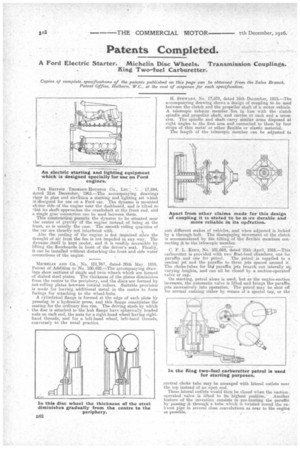Patents Completed.
Page 22

If you've noticed an error in this article please click here to report it so we can fix it.
A Ford Electric Starter. Michelin Disc Wheels. Transmission Couplings. King Two-fuel Carburetter.
• Copies. of complete specificatzons of the patents published on this page can be obtained from the Sales Branch, Patent Office, &Thorn, W.C., at the cost of sixpence for each specification.
TliE BRiTIsH THOMSON -HOUSTON CO., LTE , 7: . 17,844, dated 21st December, 1915.—The accompanying drawings show in plan and elevation a starting arid lighting set which is designed for use on a Ford car. The dynamo is mounted at one side -of the engine near the dashboard, and is tilted so that its shaft approaches the crankshaft at the front end, and a single gear connection can be used between them.
This constriletiun permits the dynamo to be situated near the centre of gravity of the engine instead of being at the front, as is usually the case. The smooth riding qualities of the car are thereby not interfered with. • N Also the cooling of the engine is not impaired since the draught of air from the fan is not impeded in any way. The dynamo ,itself is kept cooler, and it is readily accessible by biting the floorboards in front of the driver's seat. Finally, it can be installed without disturbing the front and side water connections of the engine.
'MICHELIN AND CO., No. 101,767, dated20th May, 1916, Patent of Addition to No. 100.498.—The accompanying draw. ings show sections of single and twin wheels which are formed of dished steel plates. The thickness of the plates diminishes from the centre to the periphery, and the discs are formed by hot-rolling plates between conical rollers. suitable provision is made for leaving additional metal in the centre to form facings for attaching to the wheel-hubs.
A cylindrical flange is formed at the edge of each plate by pressing in a hydraulic press, and this flange constitutes the seating for the ordinary tire rim. The driving studs by which • the disc is attached to the hub flange have spherically headed nuts on each end, the nuts for a right-hand wheel haying righthand threads, and foi. a left-hand wheel, left-hand threads, conversely to the usual practice.
H. STEWART, No. 17,578, dated 16th December, 1915.—The accompanying drawing shows a design of coupling to be used between the clutch and the propeller shaft of a motor vehicle. A telescopic tubular member lies in line with the clutch spindle and propeller shaft, and carries at each end a crossarm. The spindle and shaft carry similar arms disposed at right angles to the first arm and connected to them by four strips of .thin metal or other flexible or elastic material.
The length of the telescopic member can be adjusted to suit different makes of vehicles, and when adjusted is locked by a through-bolt. The disengaging movement of the clutch is accommodated by the tilting of the flexible members connecting it to the telescopic Member.
C. F. .L. KING, No. 101,668, dated 25th April, 1916.—This carburetter is provided with two flat-feed chambers, one for paraffin and one for petrol. The petrol is supplied to a central jet and the paraffin to three jets spaced around it. The choke-tubes for thrl paraffin jets braech out laterally at, varying heights, and can all be closed by a suction-operated valve or cap.
On starting, petrol alone is used, but as the engine-suction increases, the automatic valve is lifted and brings the paraffin jets .successively into operation. The petrol may be shut off for normal running either by means of a special tap, or the central choke tube may be arranged with lateral outlets near the top instead of an open end.
• These lateral outlets would then be closed when the suction-, operated valve is lifted to its highest position. Another feature of the invention consists in pre-heating the paraffin by passing it through a tube which is twisted round the ex
Must pipe in several close convolutions as near to the engine as possible.






















